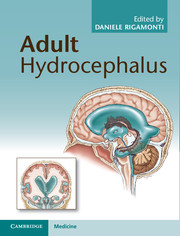Book contents
- Adult Hydrocephalus
- Adult Hydrocephalus
- Copyright page
- Dedication
- Dedication
- Contents
- Contributors
- Prologue
- Section 1 Basic sciences
- Section 2 Pathophysiology
- Section 3 Diagnosis
- Section 4 Treatment and outcomes
- Section 5 Associated conditions
- 21 Normal pressure hydrocephalus syndrome secondary to hemorrhage, infection, and malignancy
- 22 Low-pressure syndromes and cerebrospinal fluid leaks
- 23 Management of the adult with congenital hydrocephalus
- 24 Management of hydrocephalus with associated cerebrospinal fluid pathologies
- 25 Chiari malformation and hydrocephalus in adults
- 26 Pseudotumor cerebri syndrome
- Epilogue
- Index
22 - Low-pressure syndromes and cerebrospinal fluid leaks
Diagnosis and management
from Section 5 - Associated conditions
Published online by Cambridge University Press: 05 February 2014
- Adult Hydrocephalus
- Adult Hydrocephalus
- Copyright page
- Dedication
- Dedication
- Contents
- Contributors
- Prologue
- Section 1 Basic sciences
- Section 2 Pathophysiology
- Section 3 Diagnosis
- Section 4 Treatment and outcomes
- Section 5 Associated conditions
- 21 Normal pressure hydrocephalus syndrome secondary to hemorrhage, infection, and malignancy
- 22 Low-pressure syndromes and cerebrospinal fluid leaks
- 23 Management of the adult with congenital hydrocephalus
- 24 Management of hydrocephalus with associated cerebrospinal fluid pathologies
- 25 Chiari malformation and hydrocephalus in adults
- 26 Pseudotumor cerebri syndrome
- Epilogue
- Index
Summary
Keywords
- Type
- Chapter
- Information
- Adult Hydrocephalus , pp. 256 - 263Publisher: Cambridge University PressPrint publication year: 2014

